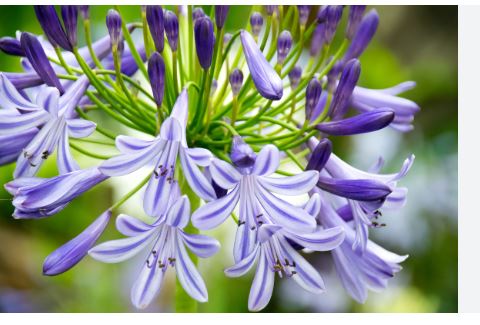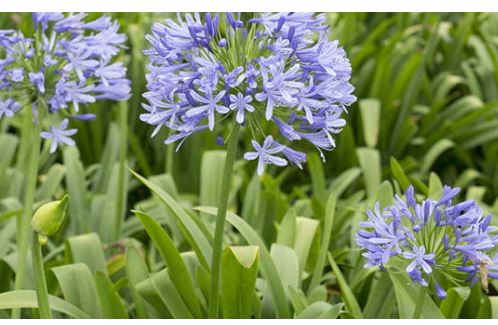
The African Lily (Agapanthus), commonly known as Lily of the Nile or Blue Lily, is a striking perennial plant celebrated for its vibrant, globe-shaped clusters of blue, purple, or white flowers and lush, strap-like foliage. Native to Southern Africa, this elegant plant has captivated gardeners worldwide with its bold blooms and versatility in landscapes, containers, and floral arrangements. Often mistaken for a true lily, Agapanthus belongs to its own unique family and offers low-maintenance beauty for both novice and experienced gardeners.
Botanical Classification
The African Lily belongs to the following taxonomic classification:
- Kingdom: Plantae
- Phylum: Tracheophyta
- Class: Liliopsida
- Order: Asparagales
- Family: Amaryllidaceae
- Subfamily: Agapanthoideae
- Genus: Agapanthus
- Species: Common species include Agapanthus africanus, Agapanthus praecox, Agapanthus orientalis, and Agapanthus inapertus
Historically, Agapanthus was classified under the Liliaceae or Alliaceae families, but modern taxonomy places it in the Amaryllidaceae family, within its own subfamily, Agapanthoideae. The genus name Agapanthus derives from Greek: agape (love) and anthos (flower), meaning “flower of love,” reflecting its enchanting blooms.
The genus includes approximately 6–10 species, with numerous hybrids and cultivars, such as ‘Peter Pan’ (dwarf), ‘Storm Cloud’ (deep blue), and ‘Snowball’ (white). Most cultivated Agapanthus are hybrids, primarily derived from A. praecox and A. africanus, offering a range of flower colors and sizes. Plants are propagated via division, seeds, or tissue culture, with division being the most common for maintaining cultivar traits.
History of the African Lily

The African Lily’s history begins in Southern Africa, where it has thrived for millennia in the region’s grasslands and rocky slopes. Indigenous to South Africa and Lesotho, Agapanthus was used by local communities, such as the Xhosa and Zulu, for medicinal and cultural purposes. The plant’s rhizomes were employed in traditional remedies for ailments like colds, swelling, and fertility issues, and as protective charms during pregnancy, earning it the Zulu name uBani (lightning plant) for its believed ability to ward off storms.
European explorers, particularly the Dutch and British, encountered Agapanthus in the 17th century during colonial expeditions. The plant was introduced to Europe in the late 1600s, with Agapanthus africanus documented in 1679 at the Cape of Good Hope. By the 18th century, it became a prized ornamental in English and European gardens, valued for its exotic beauty and ability to thrive in Mediterranean-like climates. Botanists like Carl Linnaeus classified it, and hybridizers began developing cultivars with larger blooms and varied colors.
In the 19th and 20th centuries, Agapanthus spread to North America, Australia, and New Zealand, becoming a staple in temperate and subtropical gardens. Its popularity surged in California and Australia, where it’s used in coastal landscapes for its drought tolerance. Today, Agapanthus is cultivated globally, with breeding programs in South Africa, New Zealand, and the UK producing vibrant hybrids like ‘Blue Storm’ and ‘Ever Sapphire’. Despite its beauty, Agapanthus is considered invasive in some regions, such as parts of Australia and New Zealand, prompting careful management to prevent ecological impact.
Native Area
African Lilies are native to Southern Africa, primarily South Africa and Lesotho, where they grow in diverse habitats, from coastal plains to mountainous regions. Key native regions include:
- Western Cape: Agapanthus africanus thrives in fynbos ecosystems, favoring rocky slopes and sandy soils.
- Eastern Cape and KwaZulu-Natal: Agapanthus praecox grows in grasslands and coastal areas with summer rainfall.
- Drakensberg Mountains: Agapanthus inapertus is found in higher altitudes, tolerating cooler conditions.
These species prefer well-drained soils, full sun, and seasonal rainfall, adapting to both Mediterranean (winter rain) and subtropical (summer rain) climates. Today, Agapanthus is cultivated worldwide in tropical, subtropical, and temperate regions, including:
- North America: California, Florida, Texas
- Europe: Mediterranean countries (Spain, Italy, France)
- Oceania: Australia, New Zealand
- Asia: Japan, South Korea (in protected gardens)
Identifying Characteristics
- Flowers: Agapanthus produces umbels (globe-shaped clusters) of trumpet-shaped flowers, typically 2–4 inches long, on sturdy flower stalks (scapes) rising 1–4 feet tall. Colors range from deep blue and purple to white, with hybrids offering shades like lavender, sky blue, or bicolor. Each umbel contains 20–100 flowers, blooming for 4–8 weeks in summer.
- Foliage: Leaves are strap-like, evergreen or deciduous (depending on species/cultivar), and arching, forming dense clumps. They are 6–24 inches long, dark green or variegated (e.g., ‘Gold Strike’ with yellow stripes), and arise from fleshy rhizomes.
- Rhizomes: The plant’s thick, fleshy rhizomes store water and nutrients, aiding drought tolerance. They spread slowly, forming clumps up to 2–3 feet wide.
- Fruit/Seeds: After flowering, Agapanthus produces green seed pods that turn brown, releasing black, winged seeds. Seeds are viable but take 2–3 years to flower, so division is preferred for propagation.
- Growth Habit: Agapanthus is a clump-forming perennial, with evergreen types (A. praecox) suited to milder climates and deciduous types (A. inapertus) tolerating colder conditions. Dwarf cultivars (e.g., ‘Peter Pan’) grow 8–18 inches tall, while standard varieties reach 2–4 feet.
- Aroma: Flowers are lightly fragrant or scentless, depending on the cultivar, with some hybrids like ‘Fragrant Blue’ offering a subtle sweet aroma.
Season Availability
- Blooming Season:
- Southern Hemisphere (native South Africa): Flowers appear in December–February (summer).
- Northern Hemisphere: Blooms from June–August, extending to September in milder climates (Zones 9–11).
- Cooler Climates (Zones 7–8): Blooming may start later, around July, and last 4–6 weeks.
- Plant Availability:
- Nurseries/Garden Centers: Agapanthus plants, bulbs, or potted specimens are available year-round in Zones 8–11, with peak stock in spring (March–May) for planting. In colder zones, bulbs are sold in spring or fall.
- Online Retailers: Vendors like Burpee, White Flower Farm, and Brent and Becky’s Bulbs offer Agapanthus year-round, with shipping timed for planting seasons.
- Cut Flowers: Agapanthus blooms are available as cut flowers in summer at florists or farmers’ markets, lasting 7–10 days in vases with proper care.
- Propagation Timing:
- Division: Divide rhizomes in spring or fall every 3–5 years to maintain vigor and propagate.
- Seeds: Sow in spring, though seedlings take 2–3 years to bloom.
- Storage: Store bare rhizomes in a cool, dry place (50–60°F) over winter in colder zones, replanting in spring.
Uses
- Ornamental Landscaping:
- Borders and Beds: Agapanthus’ bold blooms and tidy foliage create stunning garden borders, mass plantings, or focal points. Dwarf cultivars like ‘Peter Pan’ suit small spaces.
- Containers: Ideal for patios, balconies, or terraces, especially in colder zones where pots can be moved indoors. Use well-draining potting mix and large containers (12–18 inches wide).
- Rock Gardens: Drought-tolerant varieties thrive in rockeries or xeriscapes, complementing succulents or grasses.
- Coastal Gardens: Salt-tolerant, making them perfect for seaside landscapes in California or Australia.
- Cut Flowers and Floral Arrangements:
- Agapanthus’ long-lasting blooms are used in bouquets, centerpieces, and wedding arrangements, adding vibrant blue or white accents. Cut stems at a 45-degree angle and change vase water every 2–3 days to extend life.
- Medicinal and Cultural Uses:
- In South Africa, rhizomes are used in traditional medicine to treat colds, inflammation, and fertility issues, though scientific validation is limited. Caution: All parts are toxic if ingested, causing nausea or irritation.
- Among the Zulu, Agapanthus is a protective charm, planted near homes to ward off lightning or used in pregnancy rituals.
- Ecological Benefits:
- Pollinator-Friendly: Flowers attract bees, butterflies, and hummingbirds, supporting biodiversity.
- Erosion Control: Rhizomatous roots stabilize slopes or banks, preventing soil erosion.
- Groundcover: Low-growing cultivars like ‘Tinkerbell’ serve as groundcover, suppressing weeds and adding texture.
- Interior Decor: Potted Agapanthus brightens indoor spaces in bright, indirect light, with blooms adding a tropical flair.
Fun Fact
The African Lily, known as the “flower of love,” is a South African superstar, often planted around homes to protect against lightning, earning it the Zulu nickname uBani (lightning plant)! In Victorian England, its blue blooms symbolized hope and devotion, making it a favorite in romantic gardens. Legend has it that Agapanthus’ vibrant flowers inspired the Cape Town Flower Festival, where locals celebrate its beauty with colorful parades. Gardeners swear its rhizomes are so tough they can survive being dug up and replanted years later, blooming as if nothing happened!
Care and Cultivation Tips for African Lily Plants
- Planting: Plant in spring or fall in a sunny, well-drained site. Dig a hole 6–8 inches deep, place rhizomes 1–2 inches below the surface, and space 12–24 inches apart. In containers, use a well-draining potting mix and ensure drainage holes.
- Watering: Water weekly during establishment, reducing to every 10–14 days once mature. Allow soil to dry between waterings to prevent rot. Drought-tolerant but blooms best with consistent moisture.
- Fertilization: Apply a balanced fertilizer (e.g., 10-10-10) in spring to promote growth and a high-phosphorus fertilizer (e.g., 5-10-10) before blooming to enhance flowers. Avoid over-fertilizing, as it encourages foliage over blooms.
- Pruning: Deadhead spent flower stalks to tidy plants and encourage reblooming. Remove yellowing leaves in fall for deciduous types or year-round for evergreens. Divide clumps every 3–5 years to prevent overcrowding.
- Pest and Disease Control: Agapanthus is relatively pest-resistant but may attract snails, slugs, or aphids. Use organic controls like slug traps or neem oil. Watch for root rot in poorly drained soils; ensure proper drainage. Fungal leaf spots are rare but treatable with fungicides.
- Winter Protection: In Zone 7, mulch heavily (6–12 inches) and cover plants during freezes. In colder zones, dig up rhizomes or move potted plants indoors to a cool, bright space (40–60°F). Reduce watering during dormancy.
- Invasive Management: In regions like Australia, prevent seed spread by deadheading and monitor for unwanted rhizome growth. Check local regulations before planting.
Challenges and Considerations
- Invasiveness: Agapanthus can become invasive in mild climates (e.g., Australia, New Zealand), outcompeting native plants. Remove seed heads and control spread.
- Toxicity: All parts are toxic to humans and pets, causing nausea or skin irritation. Handle with gloves and keep away from children and animals.
- Cold Sensitivity: Evergreen types are frost-tender, requiring protection in Zone 8 or colder. Deciduous types are hardier but still need mulching.
- Bloom Failure: Insufficient sun, over-fertilization, or overcrowding can reduce flowering. Ensure full sun and divide clumps regularly.
- Space Requirements: Clumps expand over time, needing space in borders or large containers.